Trading strategies
Explore practical techniques to help you plan, analyse and improve your trades.
Our library of trading strategy articles is designed to help you strengthen your market approach. Discover how different strategies can be applied across asset classes, and how to adapt to changing market conditions.


Most traders understand EA portfolio balance through the lens of traditional risk management — controlling position sizes, diversifying currency pairs, or limiting exposure per trade.
But in automated trading, balance is about deliberately constructing a portfolio where different strategies complement each other, measuring their collective performance, and actively managing the mix based on those measurements.
The goal is to create a “book” of EAs that can help diversify performance over time, even when individual strategies hit rough patches.
A diversified mix of EAs across timeframes and assets can, in some cases, reduce reliance on any single strategy. This approach reduces dependency on any single EA’s performance, smooths your overall equity curve, and builds resilience across changing market conditions.
It’s about running the right mix, identifying gaps in your coverage, and viewing your automated trading operation as an integrated whole rather than a collection of independent systems.
Basic Evaluation Metrics – Your Start Point
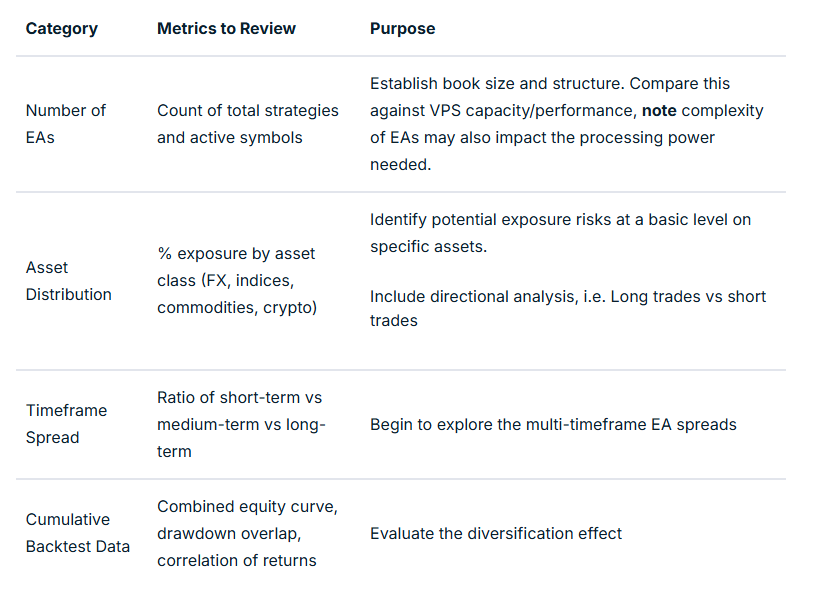
Temporal (timeframe) Balancing
When combined, a timeframe balance (even on the same model and instrument) can help flatten equity swings.
For example, a losing phase in a fast-acting M15 EA can often coincide with a profitable run in an H4 trend model.
Combining this with some market regime and sessional analysis can be beneficial.
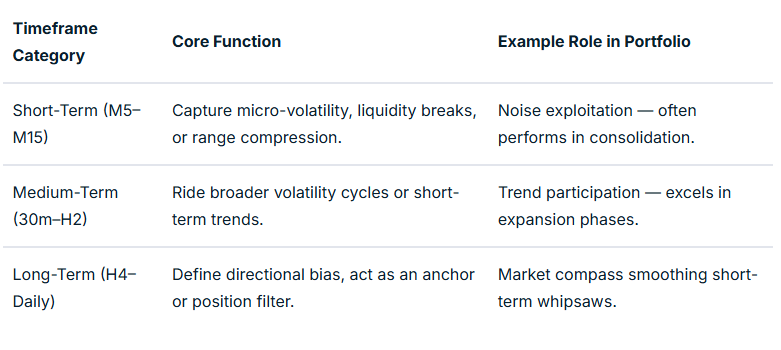
Asset Balance: Managing Systemic Correlation Risk
Running five different EAs on USDJPY might feel diversified if each uses different entry logic, even though they share the same systemic market driver.
But in an EA context, correlation measurement is not necessarily between prices, but between EA returns (equity changes) relating to specific strategies in specific market conditions.
Two EAs on the same symbol might use completely different logic and thus have near-zero correlation.
Conversely, two EAs on a different symbol may feel as though they should offer some balance, but if highly correlated in specific market conditions may not achieve your balancing aim.
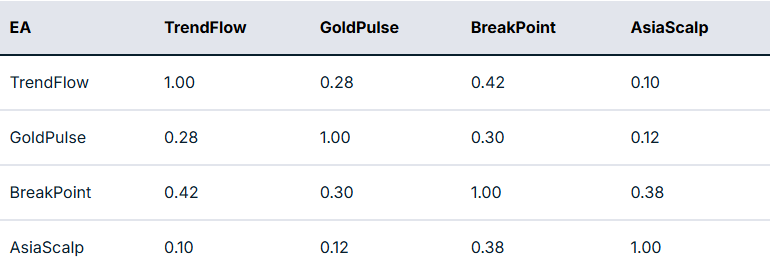
In practical terms, the next step is to take this measurement and map it to potential actionable interventions.
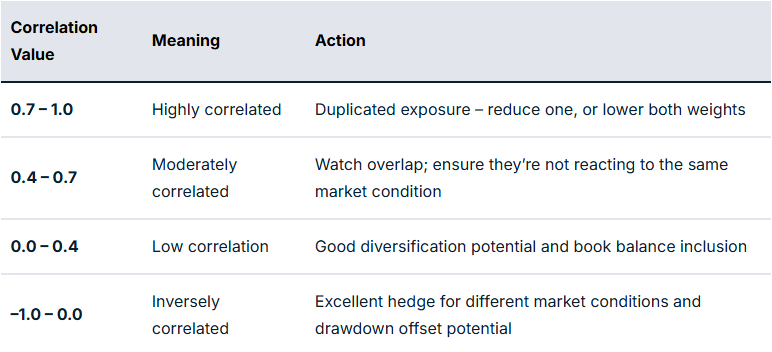
For example, if you have a EURUSD Trend EA and a GBPUSD Breakout EA with a correlation of 0.85, they are behaving like twins in performance related to specific market circumstances. And so you may want to limit exposure to some degree if you are finding that there are many relationships like this.
However, if your gold mean reversion EA correlates 0.25 compared to the rest of your book, this may offer some balance through reducing portfolio drawdown overlap.
Directional and Sentiment Balance
Markets are commonly described as risk-on or risk-off. This bias at any particular time is very likely to impact EA performance, dependent on how well balanced you are to deal with each scenario.
You may have heard the old market cliché of “up the staircase and down the elevator shaft” to describe how prices may move in alternative directions. It does appear that optimisation for each direction, rather than EAs that trade long and short, may offer better outcomes as two separate EAs rather than one catch-all.
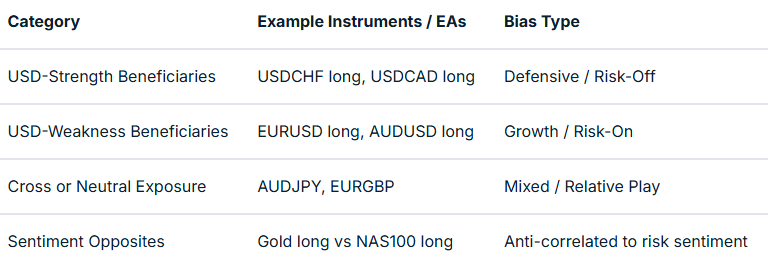
Market Regime and Volatility Balance
Trend and volatility states can have a profound impact on price action, whether as part of a discretionary or EA trading system. Much of this has a direct relationship to time of day, including the nature of individual sessions.
We have a market regime filter that incorporates trend and volatility factors in many EAs to account for this. This can be mapped and tested on a backtest and in a live environment to give evidence of strategy suitability for specific market conditions.
For example, mean reversion strategies may work well in the Asian session but less so in strongly trending markets and the higher volatility of the early part of the US session.
As part of balancing, you are asking questions as to whether you actually have EA strategies suited to different market regimes in place, or are you using these together to optimise book performance?
The table below summarises such an approach of regime vs market mapping:
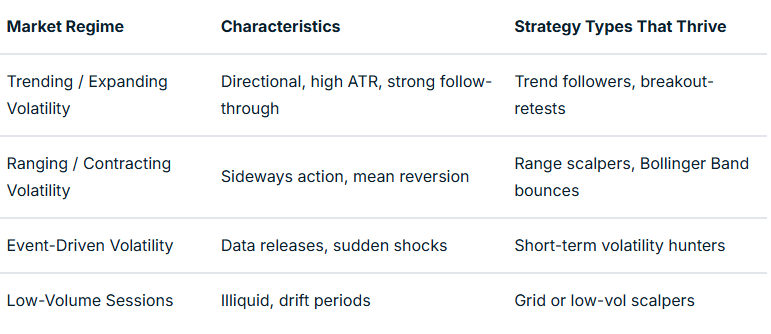
Multi-Level Analysis: From Composition to Interaction
Once your book is structured, the challenge is to turn it into something workable. An additional layer of refinement that turns theory and measurement into something meaningful in action is where any difference will be made.
This “closing the circle” is based on evidence and a true understanding of how your EAs are behaving together. It is the step that takes you to the point where automation can begin to move to the next level.
Mapping relationships with robust and detailed performance evaluation will take time to provide evidence that these are actually making a difference in meeting balancing aims.
To really excel, you should have systems in place that allow ongoing evaluation of the approaches you are using and advise of refinements that may improve things over time.
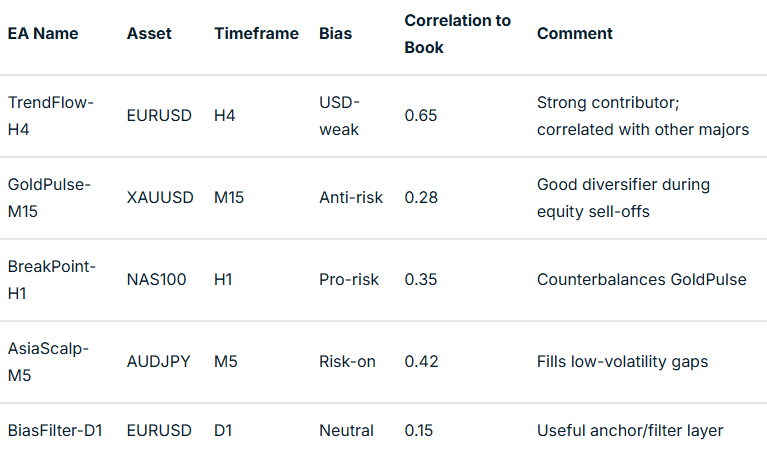
What Next? – Implementing Balance in Practice
Theory must ultimately translate into an executable EA book. A plan of action with landmarks to show progress and maintain motivation is crucial in this approach.
Defining classification tags, setting risk weights, and building monitoring dashboards are all worth consideration.
Advanced EA traders could also consider a supervisory ‘Sentinel’ EA, or ‘mothership’ approach, to enable or disable EAs dynamically based on underlying market metrics and external information integrated into EA coding decision-making.
Final Thoughts
A balanced EA portfolio is not generated by accident; it is well-thought-out, evidence-based and a continuously developing architecture. It is designed to offer improved risk management across your EA portfolio and improved trading outcomes.
Your process begins with mapping your existing strategies by number, asset, and timeframe, then expands into analysing correlations, directional bias, and volatility regimes.
When you reach the stage where one EA’s drawdown is another’s opportunity, you are no longer simply trading models but managing a system of EA systems. To finish, ask yourself the question, “Could this approach contribute to improved outcomes over time?”. If your answer is “yes,” then your mission is clear.
If you are interested in learning more about adding EAs to your trading toolbox, join the new GO EA Programme (coming soon) by contacting [email protected].


Many traders recognise the positive nature of the theoretical philosophy of treating your trading as you would a business, and yet the majority are unsure about what this may mean in practical terms and fail to move beyond the “hobby trader” in their trading activity. Recognising the potential wisdom of a “trading business approach”, this article attempts to differentiate between these business and hobby approaches through looking at eight key attributes. The aim has been to offer a checklist for the reader to: Make a judgement about where they are now in the business V hobby concept; and Facilitate decision making about what potentially to work on to move towards trading as a business.
We have organised the thinking in a table for ease of use. This is of course not an exhaustive list and offers overview information rather than major detail, but should be sufficient to encourage individual thinking of where you are. So, your eight attributes are as follows: Attribute Trading as a business Trading as a hobby Level of commitment Significant planning and follow through for trading activity.
Recognises the need to work hard at the front end to obtain sustainable results Likes the "idea" of trading, believes that can succeed with minimal effort Trading plan Comprehensive, specific statements relating to entry, exit, position sizing, strategy outlines and IS dynamic and IS used. May have some entry indictors and loose exit guidance, ambiguous statements that do not facilitate consistency and measurement. Measurement and testing Knows key trading numbers and journals trades.
Review system in place which involves action planning to revise trading plan based on evidence. Focus on limited trade information often restricted to P/L of individual trades. Changes to trading plan often based on a whim or the next new indicator.
No study of decision making. Time management Has a clear plan for all aspects of trading activity. Optimises the limited time for trading based on lifestyle and objectives No time planning evident.
Often uses time inefficiently or may have a distorted trading/life balance. Learning approach Develops and implements a trading development plan based on identifying and filling gaps in knowledge/skills that may most impact on results. No systemised approach to learning.
May attend webinars/seminars without follow through. Unaware of/ignores gaps in knowledge/skills and often trades what others trade. System changes Based on evidence gained from measurement.
Has the information to compare and adjust indictor perimeters and add new criteria for entry/exit. Based on a whim or the hope that a new indictor (usually entry only) may produce better results without rigour in forward testing. Purpose Has a clear purpose for trading based on creating additional lifestyle choices and views trading as a potential vehicle to get there.
Purpose is to profit without obvious reason beyond making money. May like to trade as it "feels good” to be a trader. Discipline Religiously follows a plan for the majority of time as recognises that this is the ONLY way to determine whether a system works or needs adjustment.
Fails to execute according to plan. May more commonly miss entries/optimum exit points or enter/exit earlier than plan states. So, assuming you may have a desire towards the trading as a business idea, your mission should be clear.
Take the information in this article and make a judgement as to what you could work on next.


There are few times when the market (irrespective of trading vehicle) is more likely to move in price quickly than on the release of some economic data. Judging potential market response can be complex as often many data points are released in quick succession but is an important component of overall risk management relating to your trading positions and account generally. This article aims to provide you with some things to consider in your trading development and systems.
As a trader you need to: Understand the basics of why markets move in response to data. Have an indication not only as to when data is due but its potential impact on financial instruments you may be trading, to make some judgement on risk. Have articulated within your trading plan how you are to manage both potential entries and open positions when sensitive economic news is due.
So, your major five factors are: 1. Data type Obviously, not all economic data has the same level of impact. The way data is perceived in terms of importance has a general relationship to how it either: a.
Indicates the health of a specific economy (and in some cases a global indication). b. Is likely to impact on central bank decision making e.g. with interest rates decisions. To give an example, automobile sales data is unlikely to have a major impact on many trading positions and instruments except for transport related share CFDs, whereas employment data can significantly not only relate currency pairs but Index CFDs and share CFD positions.
The general “impact level” is illustrated commonly on economic calendars. On the GO Markets’ economic calendar on the website this is shown as a colour coded volatility measure (see image below). Please note that this measure relates to the potential impact on currency pairs only.
For potential impact on other instruments, this should be a planned part of learning to trade. 2. Data versus instrument You may currently trade, or plan to in the future a one or more different financial instruments on your trading account. These may include: • Forex, • Index CFDs • Commodity CFDs • Share CFDs As well as the country of origin with an impact on relevant forex pairs, as previously referenced some data (particularly from the US, China or Eurozone) often has a broader “whole market” influence.
The “whole market” extends beyond Forex and for major data news will impact on all instruments. Your challenge is to identify what this impact and as importantly the direction of price move may be. For example, major jobs data such as the US non-farm payrolls (monthly employment), may alter the perception of timing of any interest rate change by the US Federal Reserve.
Let us use the example of a weak number that the market takes as making a rate reduction more likely. This may weaken the USD (for Forex traders ), and so be positive on other currencies with USD within any pair. Also due to the inverse relationship with some commodities and USD, there may be a rise in precious metal CFDs.
The inference that a rate cut will put more money into the pocket of “Joe Public” could be bullish for oil CFDs. Additionally, this may be positive for US equity (and subsequently other global indices) which will have a positive price impact on non-US Index CFDs. Also, of course, if there is a positive price move in indices, related Share CFDs could generally rise with a positive price move on indices.
Your challenge therefore is to learn through observation the impact of certain data points on different instruments. 3. Overall market sensitivities Some potential market responses are dependent on general state on local and global economic outlook. This may influence the more likely scenarios for the impending data release.
An obvious example of this would be interest rate decisions. In this case there are 3 possible options for a central i.e. to pause, raise or reduce interest rates. Although theoretically all three could be possible, it is usually a pause or EITHER of the other two not both.
To use this example further, in times when the market is uncertain about timing of rate changes, it could be “interest rate sensitive”. As central banks utilise jobs and CPI (inflation) data as key part of their decision making, at such sensitive times, the impact of these data points may be more acute than in other times where there is no expectation of potential change in the next few months. To give another example, if the financial markets are concerned about global economic growth then GDP, industrial production and PMI data is likely to illicit more of a response than if such concerns didn’t exist.
Although this may be sometimes difficult to gauge and so legislate for in your overall market risk assessment, keeping abreast of general financial news and market opinion often will provide a consensus view as to what scenarios are more likely. 4. How you are positioned If you have more than one trading position open (and potentially across several different trading instruments) it is important to note that a single data point can influence positions similarly or have counter effects on different positions. Firstly, let’s give an example of three trades you could have open… Long AUDUSD Short USDJPY Long EURUSD With a data point that may have a large general impact on USD this will have a potential 3 times risk on your account equity If you have positioned sized with a 2% per trade risk for each.
Then add to that a Long GOLD CFD (XAUUSD) perhaps. You have added another “anti-USD” position that is likely to move in the same direction as the above. Let’s say that the data will have a negative impact on the US equity markets also, make the assumption that the ASX often is led by what happens in the US overnight and if you have a couple of long CFD positions, these could also move against you at the same time as other open positions as described.
One last point on number of positions, there is no doubt that the more positions you have open, the more complex it is to make “whole” accounts decisions. So, what this means for you is: a. Set a maximum number of positions to have open at any one time. b.
Know the potential impact on all instruments you are trading at any specific data point. c. Consider your risk level you are exposed to across all positions and plan stop/trail stop levels or potential closing of some positions accordingly. 5. Timeframe Although it is difficult to accurately quantify and even more so when considering multiple data releases, some awareness of the longevity of a market response, including whether a trend change is likely, will be different depending on what timeframe you are trading.
Commonly, economic data release and types are likely to have more “acute” impact on shorter timeframes than longer. If trading daily charts, with a smaller position and wider stop, there may be less implication on relative price movement and account position with an often a short-term market move which doesn’t impact long term trend. The reverse could be the case than for example due to CPI or PMI data, if trading a 15-minute larger position with a tighter stop, where short term price and the trend may be impacted upon quickly.
Experience is a good teacher in this case as to creating general rules, and like many aspects of your trading planning and action, merits considering lower position exposure until you are at a point where creating individual “rules” for you can be established with some confidence. In summary, as with many aspects of trading, at a beginner trading level, learning that data does have impact and having a ‘check in’ and basic plan to manage risk and opportunity is undoubtedly important as you find your “trading legs”. Even knowledge of some of the things discussed in this article will be useful in terms of increasing understanding.
As you develop some experience considering what we have covered above, is next level refinement (and we know that details often DO matter when trading) of your plan and actions you choose to take could, and arguably should, be part of your thinking going forward. We are always here to help. Our on-going education of the ‘Inner Circle’ programme that we offer will help not only in seeing the practical implications of the content above but also give opportunities for you to ask questions and gain clarity of this and other aspects of your trading live.


In our previous articles we introduced the SIX steps to improving your trading discipline, offered some guidance on developing “awareness” and explored how to prioritise the trading discipline areas. If you haven’t yet read these articles, perhaps it is worth checking them out before moving onto this one. Step 1 - Awareness Step 2 - Prioritise and Identify your cause This third step aims to take those prioritised areas and create as many compelling reasons to change the thinking from “It would be good to work on” to an “I MUST work on…”.
Why is this necessary? We all recognise that working on anything to do with your trading, be it a knowledge gap, developing a new system or the on-going commitment of keeping a journal for example will require effort and time. In our busy lives it is sometimes difficult to create this without a compelling reason to do so.
We need a perceived level of necessity to enable us to push through and act.Hence the more motivation we can create that this IS a necessity will serve us well in follow through. Adults are invariably motivated to consider change based on perceived level of pleasure or pain of taking action/inaction. If we are comfortable in what we are doing or haven’t got an obvious reason to make this effort and invest the time we will tend to be less motivated to change anything to do with our trading.
Hence, what is being suggested is through identifying the pleasure (or in other words a potential positive impact on trading results or the potential pain (or in other words possible negative outcomes of not acting), this may assist in creating this motivation. And so, onto the practical So, this practical step involves this process of quite simply identifying the implications of what you are doing and creating that impetus to act. Let’s use an example to help get you started.
You have identified previously that your “trail stop strategy” within the exit component of your trading plan needs to be written and followed. Now you have a simple statement suggesting “I will trail my stop when a trade goes in my desired direction”. You have recognised that although the idea of trailing a stop is referenced there is a lack of specific instruction as to how you are going to do this.
So, get time to get busy and create that motivation to amend this to better serve you. Get a piece of paper (or get on your PC and open a word document) and create two sections. In section one you list the potential positive trading outcomes (pleasure) that could result if you DO act.
In section two the potential negative trading outcomes (pain) that could result from NOT acting. So, it could look something like the table below: It is worth note that the last statement essentially in a summary statement which references results. This was your impetus for choosing this as a potential priority area and reinforces this psychologically helping you to lock in the importance of addressing this.
Now remember, the purpose of this approach is to get you to take initial action, to ‘press the button: on doing something. Your next challenge which we will address in the next "discipline steps" article, is about turning this theoretical reason to act into actual execution, and in some cases, with areas that require on-going input, to maintain your required motivation through creating an effective trading habit.


Warning: Turn your sensitivity meter down a little. This is a no sugar-coating, tell-it-how-it-is article (but rest assured it comes from a nurturing place). All over the globe, trading gurus attempt to sell their wares (software, the ‘holy grail’ of trade set ups etc) using retrospective charting examples.
Such powerful visual “evidence” is often used to persuade prospective FX clients that this vehicle is ‘easy’ to make profit with. With little work, little time, or whatever marketing buttons they are using to press to get a response. So, hours of energy invested, often cash is exchanged and yet more often than not, with an off the shelf system in place (often just an entry system which we know is never going to offer a complete trading solution) traders are left feeling more than a little disappointed that such “guaranteed, easy riches” are not showing up in their trading account.
On an individual level we see similar. Much airplay is given to the merits of back-testing and yet as with the aforementioned guru approach, you can just about find examples, if you look hard enough, of chart examples that mean this “next new indicator thing” is now the answer to replenish your now depleted finds. So, what happens, we have a system change, and yet results still often fall short of expectations.
There are 3 common dangers of the retrospective approach to creating (if you haven’t a trading plan already) or altering an existing plan that are worth highlighting. #1 – Overstating the function of back-testing. Let us be completely blunt. The purpose of back-testing is NOT, nor should ever be viewed as evidence that a trading plan, based on what ever system you are exploring, will work for you in the reality of live trading.
Back-testing does not generally consider: a. The impact of economic data releases and revisions, b. The political and general climate both globally and specifically in the countries that currency pairs relate to, c.
Individual investor behaviour re. timeframes, time of day that they trade, nor their ability (or otherwise) to act or inaction on a change of sentiment, d. Unplanned events such as escalating conflict (or the threat of such), e. The relationship and impact of other financial instruments of FX pairs e.g. equity and bond markets, commodities So, why back-test at all if the evidence could be so flawed?
The answer is simple, back-testing creates evidence, not that a system will definitely work for you as a trader, but ONLY as evidence that a forward (or prospective) test may be worthwhile. So, the bottom line is the function of back-testing is to justify the time and effort to prospectively test. It is after such a prospective test that system changes can be made/developed. #2 – Failure to gather a critical mass of evidence There are two issues here. a.
What constitutes enough evidence to move to the next stage of system testing. Quite often traders will make decisions on a limited amount of data e.g. one timeframe and one currency pair, over the last couple of months on which to make system decisions. Now you have read this it may seem obvious and may not need pointing out (but we will anyway) why this is insufficient information on which to base a “cross the board’ entry and exit system. b.
The second issue here is one of selective evidence gathering. A natural human response when excited by an idea is search for evidence to back up that idea. The potential danger with this is that we often tend in this search, to ignore information that refutes our idea. #3 – The reason behind doing this may not be that your system is failing rather it could be a YOU issue.
System skipping is common amongst many traders and is invariably motivated by results that are not as desired. Here is the danger. As much of what goes into creating trader results (some would suggest up to 80%) is due to behavioural issues (we have waxed lyrical about trading discipline previously) unless you: a.
Have a trading plan that is specific, measurable and comprehensive AND b. Follow it religiously ‘to the letter” then you are not really in a position to make a judgement on whether system could serve you well or is likely not to produce desired results. AND to add to this, as such behavioural issues have not been either acknowledged or addressed whatever system (based or retrospective charts or not) is more likely to produce equally disappointing results.
So, before you start on the journey of altering a system you should logically make every effort to have, follow and measure the impact of any system before you even consider changing it (or looking into what you may change it to). This MUST be your #1 priority before going down any path of system alterations. So there you have it.
You have a choice to take action of course on what you have read, If so, your missions going forward are: a. Make sure you have a comprehensive plan that you follow. Then, and only then, should you begin to explore further development including the use of retrospective charts (or back-testing) b.
Recognise the SOLE PURPOSE of back-testing is to create evidence that a forward (or prospective) live test is justified. c. Make sure you are basing any potential system change on a enough “balanced” data.


Experts suggest that 80% of your trading outcomes can be attributed to your behavioural and psychological interactions with the market. It is your mindset that determines how well you comply with good trading, even if you are sufficiently disciplined to adhere to a written trading plan, have the motivation to even write such a plan in the first place, commit to measuring your trading as logic would suggest is prudent, and do the “tough yards” in learning how to trade. Let’s get real...
Compared to the relative ease of learning a new indicator or grabbing someone else’s system to trade, this is hard for many, and falling short in this aspect of your trading (which many traders do) may ultimately be the reason why the majority of traders appear to be less than happy with their results. However REAL practical advice is often relatively scarce. One need only look at how the internet is brimming with advice on which indictors to use for entry, with only scant reference to the behavioural aspects of trading, usually summed up in a trite statement along the lines of “you must be a disciplined trader”.
This article aims to address some of these practical issues through providing 10 possible tactics that may help. Your ten tactics: 1. Awareness and acceptance is critical.
Unless you accept where you are now with your thinking, feeling and consequent behaviour, you will not move forward. 2. You have a complete trading plan that articulates trading actions before you enter and once in trades i.e. an exit strategy. The ambiguity of many trading plan statements, although better than not having a plan at all of course, does not serve in creating consistency in action in the “heat of the market”, leaving the trader more open to straying from that which was original planned. 3.
Start a journal. Sometimes the very process of formally recording what you are doing helps in doing the right thing more consistently. Of course, a journal will enable you to identify what you are REALLY doing and what contributed to decision making, is crucial to be able to pick up common threads that can be identified easily ad subsequently worked upon. 4.
Press the “reset button” on your trading account NOW. What we mean by this is an acceptance that your trading capital is what it is now. There is little point and it does not serve a positive, committed mindset if you are “stuck” in what has gone before.
If you have been on the receiving end of ‘donating’’ a proportion of your capital to the market through ill-discipline. Take your previous results as feedback, use it as the motivation to act on what has been happening. This is VITAL! 5.
Re-align with your trading purpose and plan prior to every trading session. Reminding yourself of what you MUST do and why you are doing it should be part of your daily trading ritual. 6. Make it a mission to “challenge” your existing plan on at least a 3-monthly basis through gathering an increased weight of evidence that its component parts are working for you as an individual trader.
This breeds confidence in actioning a plan, enabling more disciplined trading. 7. Beware ‘unhealthy’ statements, both externally that you may hear flying around the investment world, and the internal language that “pops up” in your head whilst trading (although this can give you clues about what is happening with you). For example, “do not invest with money you can’t afford to lose” (it makes no sense to go in to the trading arena with a mindset that it is ok if I lose my capital), or even worse, “it is not a loss until you take it”. 8.
Take regular breaks from the market during any session, particularly when trading shorter timeframes, to re-align with purpose and plan, and to mentally press your “reset button”. Remember, research suggests you are your optimum concentration level (without changing an activity) for around 20 minutes. Use “gaps” in active trading to do other things perhaps e.g. make a journal note, get your “books” up to date or even re-align with an article that has previously made a difference.
These are potentially far more fruitful than purposeless screen watching, simply observing positions move up and down. Additionally, of course, this change in activity could be helpful in maintaining concentration when you re-check in with your positions. 9. Ensure that you are trading within your level of competence i.e.
Trade ONLY what you have learned, you are more likely to revert to unhealthy actions if your confidence is low relating to what you are doing. 10. Trade smaller positions until you have evidence of developing good consistent habits that break away from your current less healthy trading state. There are a few different ways to action this, reducing your tolerable risk level significantly per trade e.g. from 3% to 1% of trading account capital, or trading micro-lots rather than mini-lots are a couple of examples.
Look down the list above and choose 2-3 that resonate with you to focus on in the first instance. Master these and then move onto the rest with the confidence that achieving a developmental goal often provides. Finally, as we have discussed before, be gentle on yourself.
There is no point in beating yourself up emotional for mistakes you may have made in the past as this is unlikely to contribute to taking some positive steps forward. There is NO successful trader we have come across that does not subscribe to continuous learning, including in this context of course, the learning you must do about yourself as a trader.


Can you teach old dogs new tricks? Yes, of course you can if you give them treats and train them correctly through the new learning process. To teach an old dog new tricks the dog handler will be re-training the dog’s brain and so it is with human beings when it comes to currency trading.
We need to re-train our brains to learn how to behave properly in the Forex market. Let me explain. Your entire life as a human you have been accustomed to a high degree of certainty and influence in most situations.
Let's say you own a business and that business is not doing well. You have the ability to change many things, the staff, the location, the stock, the equipment, the selling method, the price and even the type of customers you are selling too. The bottom line is you have the ability to change and influence virtually every situation and what I am referring too is not restricted to just business owners.
As a human being throughout your entire life you’ve had the ability to manipulate situations to get the outcomes you desire. But in the currency markets the level of control and influence you have with respect to your currency trade is extremely limited. It’s this lack of influence and control that causing so much emotion in so many forex traders.
It simply drives them crazy that they can’t influence the price. But if you re-train your brain to think in probabilities it can potentially be extremely profitable. Forex Trading success is about three important things. » Ensuring the trading system has a small edge. » Risk Management. » Behaviour.
It is not difficult to find a currency trading system that has an edge and it's not difficult to manage risk, so why is it that not everyone can trade Forex and make money? Emotional discipline is the answer and the behavioural side of currency trading is the most challenging no question but if you can re-train your brain to think in probabilities and not certainties you can potentially profit handsomely. The trading edge you’ll have using the system you trade with has a random probability of success.
Meaning over a series of forex trades it will likely make money however picking the absolute winners is impossible. Finding an edge that has the probability of making money over a series of trades as I said is not difficult but you must understand that it's a series of trades that matters and not just this trade right now. Think of it like flipping a coin.
You and I know a coin is a 50/50 bet, its heads or tails and the odds will never change. But flip a coin 10 times and you could have 7 heads and 3 tails or 6 tails and 4 heads leading someone to believe that maybe it's not 50/50. Flip it 100 times and you will very quickly see that over time it will always end up being 50/50 as it cannot be anything else.
So to re-train your brain as a currency trader you need to do the following » Pick your edge. » Apply your risk management to ensure you are not risking more than you are looking to make on each trade. » Trade your edge over 20 trades and then judge the success. Provided the system you have does have a small edge, your average win is larger than your average loss and you do actually take the trade when the edge appears for 20 trades the outcome will highly likely be that you make money. The challenging part is re-training your brain to think in numbers over a period of time and not thinking in certainties on each forex trade you enter because your human instinct will want to see a winning trade every time.
But does a Casino worry if it has a few losing hands? Of course not because over time if it keeps playing the edge which has a better than 50/50 probability they will make money over time. They do not sweat or get emotional about one roll of the dice like many traders do with one trade.
They think in probabilities and not certainties. If you’d like to learn more about how to re-train your brain as a forex trader and learn some trading edges that can be applied successfully in the market over time join me every Wednesday evening at 7pm AEST for a free currency coaching session. To log into the session simply click on the following link at 6.45pm AEST (Sydney time) to ensure you are safely logged into the web conference room. http://gomarkets.webinato.com/room1 Andrew Barnett | Director / Senior Currency Analyst Andrew Barnett is a regular Sky News Money Channel Guest and one Australia’s most awarded and respected financial experts, and is regularly contacted by the Australian Media for the latest on what is happening with the Australian Dollar.
Connect with Andrew: Email

